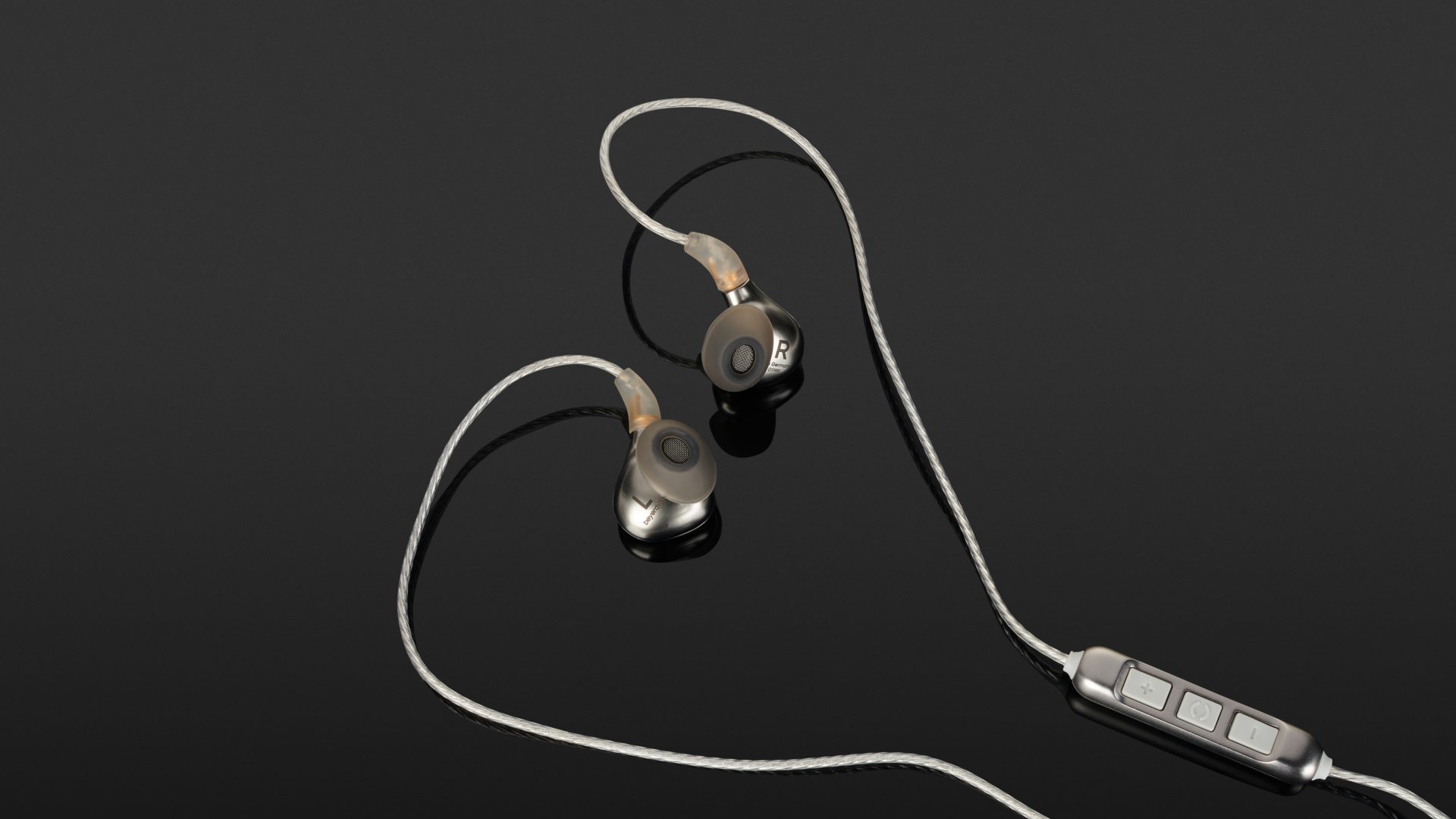The second generation of the Beyerdynamic Xelento wireless is again sonically exciting and, thanks to MOSAYC sound personalisation, even a bit more so than its predecessor with the simple remote cable. In addition, the neckband provides you with enough battery life to enjoy the beautiful sound for 14 hours without interruption. Of course, the neckband is a matter of taste and not every music lover will want to carry around this accessory in the current boom of True Wireless headphones. Fortunately, both cables are included with these in-ears, so you can switch if necessary.
- excellent sound
- solid workmanship
- wide choice of ear tips
- individualised sound profiles
- engraved serial number
- IPX4 and High-Res Audio certified
- remote cable included
- long battery life
- case a little too small for neckband
- no standard jack adapter included
The Beyerdynamic Xelento wireless (2nd generation) treats the listener to some pretty terrific sound – if you’re willing to spend around 1,200 euros on this “piece of jewellery”, as the marketing department puts it in rather florid terms.
Concept of the Beyerdynamic Xelento wireless 2nd Gen.
Basically, the Beyerdynamic Xelento remote 2 and the wireless model tested here differ from each other only in the attached cable, which connects to the in-ears via MMCX connector. The in-ears themselves are the same for both versions. In the case of the wireless version, there has been an obvious redesign. While the Bluetooth receiver module and the battery were hidden in a small metal tube with a clip in the first version, the new version has a snug neckband. The space gained from this change offers advantages: for example, the battery life can be boosted to an epic 14 hours (in the previous model, it was a still-respectable eight), and a larger Bluetooth antenna can be installed.
The exterior of the in-ears has also changed: The round, black end plate with engraved serial number has given way to a 24-carat real gold logo, and the serial number, which uniquely identifies each in-ear throughout the entire manufacturing process at the company’s Heilbronn site, can now be found on the inside. Still at the heart of these in-ears are the tried-and-tested Tesla drivers, which have a diameter of eleven millimetres, leading to the logical type designation “Tesla.11”.
Package of the Beyerdynamic Xelento Wireless 2nd Gen.
Included in the in-ears’ attractive box is an extensive accessories package: It starts with a simple remote cable (without Bluetooth function, but with remote control) with a mini-jack connection, which in a sense, turns the wireless into the Xelento remote. In addition, the user has a choice of seven pairs of silicone earpieces, as well as three pairs of memory foam, which are characterised by very effective ambient noise attenuation. The set is completed with a solid case that has a magnetic closure, which is identical in construction to the remote version. In the case of the wireless, a small space problem arises here because if you stow the neckband in it, the cable outlet is inevitably bent fairly severely, which in the long run might lead to the possibility of cable breakage.
Internal values
As expected, the technical values of the second generation of Beyerdynamic Xelento wireless are excellent. And that’s a good thing because the first Xelento – as mentioned at the beginning – was already quite a hit. The sonic powerhouse remains the Tesla driver with an eleven-millimetre diaphragm. With a frequency response of 10 Hz to 50 kHz driven and a maximum sound pressure of 114 dB, nothing is hidden from the ear in technical terms. Of course, these in-ears are High-Res Audio certified.
When it comes to Bluetooth, there are high-resolution codecs with LHDC, aptX HD and aptX Adaptive, in addition to the SBC, AAC and aptX standards. Bluetooth 5.2 is used. Externally, the in-ears are protected according to IPX4 and are thus protected against dust and moisture.
In practice
If you use the Beyerdynamic Xelento wireless with the remote cable, the in-ears can be connected directly to the external player. However, if you choose the Bluetooth connection, the neckband comes into play; this is charged via a USB-C socket on the lower right side. This is placed over the back of the neck, and the cable is then passed from behind the ear cup to the ear canal, where the Xelento find their place.
In our test, the cable proved to be a bit unruly when “laying over the ear”. I had to adjust it several times and twist the MMCX connector to get it to fit snugly around the ear. This sort of behaviour does not occur when using the remote cable, which, after all, extends downwards.
Of course, the neckband is a bit unsexy – considering the many purely in-ear headphones – but you do gain space for the battery. The lucky Xelento user can still listen to their music when the competition has long since had to return to their charging case.
If you have an Android mobile phone and use Google’s services, a whole range of additional practical functions are available to you. This starts with “Google Fast Pair”, where you only have to press the on/off button for six seconds and then simply press “Connect” on your smartphone, and goes all the way to locating the in-ears via Google Maps. The MIY app is available free of charge for both Android and iOS, and it can be used to manage a multitude of functions. First and foremost, individual sound personalisation, which measures personal frequency sensitivity based on a short listening test and generates a corresponding equalisation curve. Furthermore, all available telephone and media control functions, which can be called up via the three buttons on the remote control, can be individually configured here. An update of the firmware can also be initiated, and surprisingly, one has to plan about 22 minutes to complete it.
Sound
Even in the basic configuration, the Beyerdynamic Xelento wireless 2 sound quite excellent. The developers’ intention to balance the high-frequency range a little more and to further linearise the bass has been audibly successful. However, it becomes really impressive when you carry out the sound personalisation, which is continuously adjustable and switchable in characteristics between “softer”, “recommended”, and “richer”. This adjustment to personal hearing ability catapults these already fabulous in-ears into what I consider the “couldn’t be better” zone. However, due to the design principle, this only works with the neckband on and not simply with the remote cable.
Sound personalisation or not: the developers’ objective of giving the Xelento wireless 2 a bit more balanced treble and extended bass reproduction by means of memory filters was fully met. At any time and with any style of music, you have the great feeling of being fully supplied with all the information that the frequency spectrum of the respective recording provides. And it’s absolutely balanced and confident. The sound quality of the hands-free microphone integrated into the neckband is also more than adequate – compared to many competitors. This makes it possible to conduct even a sensitive business call without it being an imposition on the caller on the other end of the line.
Technical specifications
- Ear couplingIn-ear
- Typeclosed
- Transducer principledynamic
- Frequency response (headphones)10 - 50.000 Hz
- Impedance16 ohms
- Sound pressure level (SPL)114 dB
- Weight with cable22 g
- Cable length130 cm
What's in the box
- Silicone ear tips in 7 sizes (XS, S, M, L, XL, XXL, XXXL)
- Foam ear tips (S, M, L)
- Cerumen protective grille
- Bluetooth receiver with remote control and USB cable
- Connection cable with remote control, jack 4-pin 3.5 mm
- Cable clips (2 pcs.)
- Microfibre cleaning cloth
- Hard case
Special features
- Optional accessories: Connection cable (balanced), jack 5-pin 4.4 mm (Pentaconn); connection cable without remote control, jack 3-pin 3.5 mm


















































